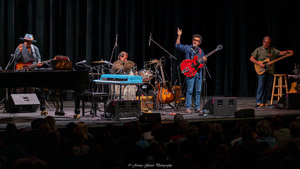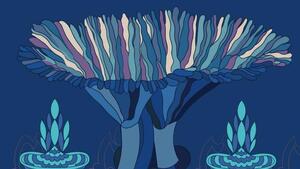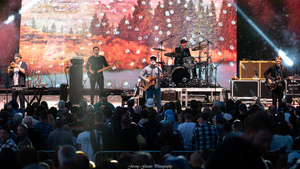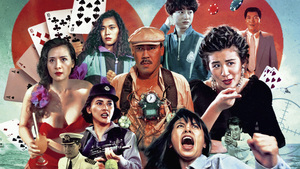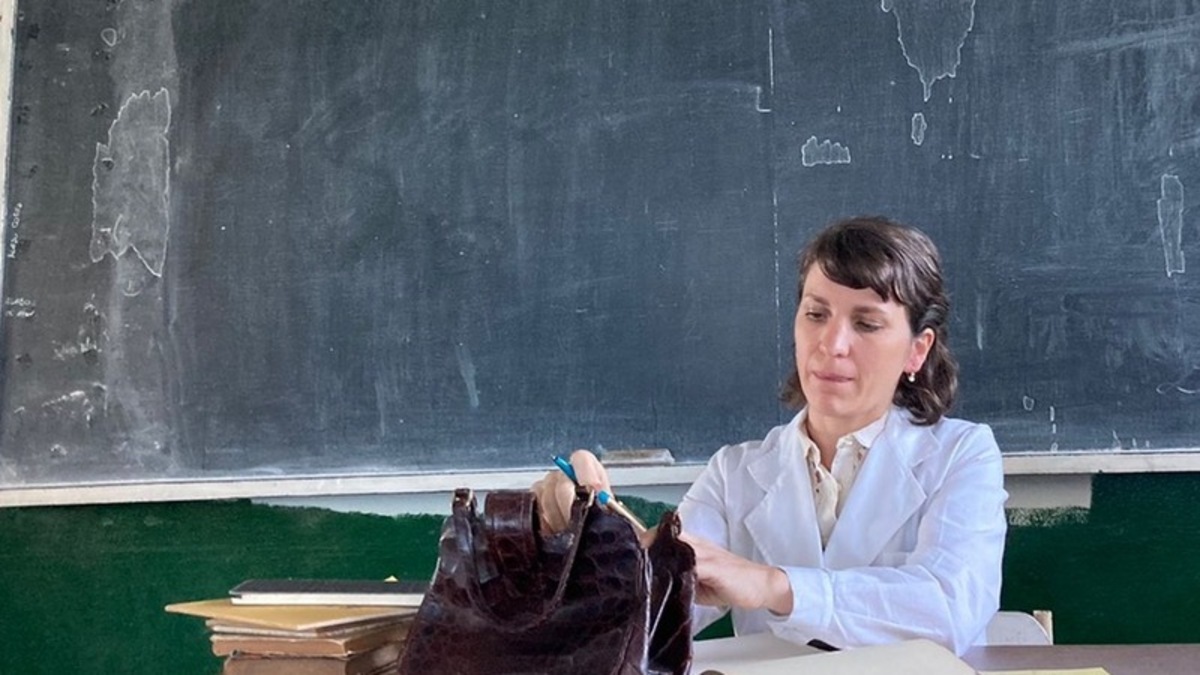
Laura Citarella
by Generoso and Lily Fierro
It’s been just over a decade since the premiere of director Laura Citarella’s feature Ostende, the film that first suggested the character of Laura, who appears at the center of her newest feature, Trenque Lauquen. During the time since Ostende, Citarella has enjoyed great success as an integral part of the famed filmmaking collective El Pampero Cine, a major force within the New Argentine Cinema movement. In 2015, Citarella, along with Verónica Llinás, co-directed the critically acclaimed naturalist feature Dog Lady (La Mujer de los Perros), and Citarella followed up that directorial effort with the release of Mariano Llinás’s 808-minute, six part masterwork, La Flor (The Flower), one of our top ten films of the 2010s, which she acted in and produced over a ten-year period. And in 2019, she co-directed the documentary Las Poetas Visitan a Juana Bignozzi with Mercedes Halfon.
Presented into two parts, Citarella’s Trenque Lauquen transforms Ostende’s passive lead character of Laura (Laura Paredes) into a determined botanist who has vanished from the titular town where she had originally been sent to complete a scholarly plant cataloging assignment. Part one begins with the introduction of the two men who are trying to track down Laura: her boyfriend from Buenos Aires and university colleague, Rafael (Rafael Spregelburd), and Ezequiel (Ezequiel Pierri), a hapless municipal driver who has become infatuated with Laura after they shared a passion for the old letters sent between two lovers (Carmen, a teacher in Trenque Lauquen, and Paolo, the father of two of her students) that Laura serendipitously found tucked into the pages of books in Trenque Lauquen’s library donated by the estate of Martín Fierro, the eponymous protagonist of the epic poem by the Argentine writer José Hernández.
Part two of Citarella’s film expands into the history of Laura’s involvement with Trenque Lauquen’s doctor, Elisa (La Flor’s Elisa Carricajo), who has asked Laura for a sample of a yellow flower. This seemingly normal botanical solicitation leads to an event where Laura uncovers Elisa and her partner Romina’s (Verónica Llinás) vocation of protecting the half-human, half-amphibian child that exists in the town’s lake, compelling Elisa and Romina to ask Laura for her assistance in cultivating plants for a habitat that can support the child’s development. Laura complies, and when Elisa, Romina, and the child must leave their home, Laura assumes a greater role in their collaborative efforts while finally and fully connecting to the world around her.
A nominee for the Horizons Award for Best Film at this year’s Venice Film Festival, we adored this emotionally complex and engrossing feature when we saw it at AFI Fest 2022, where we picked it as one of our top watches. In our discussion with Citarella, we spoke about Trenque Lauquen’s connection to José Hernández’s Martín Fierro, the evolution of the character of Laura, the shortcomings of Rafael’s and Ezequiel’s theories, and Citarella’s love of Elvis Presley’s “Suspicious Minds,” and her use of it as her protagonist’s ringtone in both Ostende and Trenque Lauquen.
• •
GF: The name Martín Fierro is a galvanizing clue for Laura in Trenque Lauquen. Martín Fierro, of course, is the legendary protagonist from José Hernández’s duet of poems El Gaucho Martín Fierro (1872) and La Vuelta de Martín Fierro (1879). In addition, the poems were written in a distinctively lyrical style that was inspired by payadas. Were Hernández’s poems a launching point for the structure and the musical nature of Trenque Lauquen? And if so, how much of the writing/experiential process of Hernández, who was well known for being a writer who lived alongside gauchos in the pampas, go into the construction of Laura’s character?
LC: As you may know, I am a part of a group of filmmakers called El Pampero Cine, and El Pampero is a wind that blows in the province of Buenos Aires, so we always work with Buenos Aires as an idea for making films, and so this is the pampas! If you go out from the city of Buenos Aires, you have the province of Buenos Aires where there are different cities, and if you go to the west, you will find Trenque Lauquen, and there you will find the pure pampas of the gaucho and everything in the world of Martín Fierro. Working in this atmosphere is a continuance of working in this place, which is very flat, and I believe that most filmmakers are afraid of shooting there because you never know how to frame it because it is a landscape that has no borders, but we love that. We love to find excuses or stories to invent that could take place in this scenery. That said, when we started working there years ago, we decided that this place would give our production company its name, El Pampero Cine. In 2011, I made a film there called Ostende, which is like the first part of Trenque Lauquen because the concept is to move from one town to another with the same character and build stories about each one, but always with the thought of portraying the pampas. We not only like to shoot in the province of Buenos Aires, but we also like being there, which is very strange as this is a province in Argentina that you usually just travel through to get to the next stop. Needless to say, this area also has an important relationship to Argentinian literature.
LF: One of the most entertaining and fascinating motifs connecting Ostende and Trenque Lauquen is the “Suspicious Minds’’ ringtone on Laura’s phone. Though the song itself and how it is played are identical in both films, the character of Laura has a different relation to the song in each. Whereas the character of Laura in Ostende is a bit lost in her life—she’s currently unemployed and living with her mom—the character of Laura in Trenque Lauquen is an accomplished researcher. Under these different circumstances, Ostende’s Laura’s actions are based on her suspicions, whereas Trenque’s Laura’s actions are based on her instincts. Was this evolution of suspicion into instinct something you wanted to be a directional guide to moving the Ostende series forward?
LC: Yes, that ringtone was chosen for this idea, apart from the fact that, back then, “Suspicious Minds” was my own personal ringtone because I have always been a huge Elvis Presley fan! My dad was a big Elvis fan, and every week, we would always watch Elvis movies together, so “Suspicious Minds’’ is a very emotional song for me. I kept that ringtone for Trenque Lauquen because I wanted to give you some clues that the character is the same, but the character in Trenque Lauquen has no past; her past is not Ostende. It is almost like The Simpsons (laughs) in that whenever a new episode comes out, everything starts again. So that was the idea, but I also wanted to confirm that the character was the same, so I chose to do this with different hints, such as the ringtone or the photo of Laura that Rafael shows everyone when he is trying to find her, which is the photo of Laura that we used for Ostende.
Apart from that, when we finished Ostende we wanted to use similar procedures of scene construction, but some years later, in the next film. However, as years go by, you are no longer the same person as a director. In between Ostende and Trenque Lauquen, I made two more films as a director, and then I also produced La Flor and other films for El Pampero Cine, so as a creator, you change, and with that, your point of view changes. So suddenly, this character that was in Ostende that was always watching situations and thinking about them alone is now involved with what is happening with the fiction of the film. In both films, she is a fan of finding fiction in places, but in the case of Ostende, she only keeps this as a mental activity, but in Trenque Lauquen, she puts her body in the situation. Therefore, if I had to say something concrete about this, it’s that I feel that, as a filmmaker, you always make the same film in one way, but you change with the years, and in some ways, I feel that the evolution of this character parallels my experiences and growth as a director. The character used to just watch, but now she is brave enough to be part of the adventure! She once was like the character in Rear Window, whereas now, she is like the main character in Vertigo.
GF: The unreliability of our own individual observations and theories is a recurring concept throughout Trenque Lauquen that impacts the experiences of many of the characters and even us as the viewers by the end of the film. The second part of the film particularly amplifies this when we find out that all of Rafael’s and Ezequiel’s hypotheses around Laura’s disappearance are proven wrong. At what point in the filmmaking or writing process did you decide that this would be the case?
LC: I like this idea, as I usually don’t like to speak directly about feminism and boys and girls, but suddenly I felt that there was an idea there: that the men are always incorrect, and the women are always right (laughs). I liked the concept, just like that of Antonioni’s L’Avventura, of a woman who disappears, and as a result, people begin to look for that woman. In the beginning, when we wrote this script, it was the other way around. It was a linear structure, but then we decided that it was much better to bring in these two men who are like bad amateur detectives. For us, this was the best way to show that this woman has disappeared. We found it more interesting to see Laura’s disappearance through the experiences of these two men, than by just seeing it directly. Also, I made a film before Trenque Lauquen called Las Poetas Visitan a Juana Bignozzi, which was a documentary, and in the structure of that film, we discovered that Juana Bignozzi was a poet who died. We were tasked with trying to reveal her profile with our film, and to accomplish this, we spoke about her and showed all of her objects until the middle of the film, when suddenly we showed a video of the poet herself. Through this process, I learned that it is very affecting to begin learning about a character through the eyes of someone else or through their objects, and that is why I waited until an hour and forty minutes into Trenque Lauquen to show Laura, and suddenly when you see her at that point, she has a mystery about her because you already are aware of the fact that she has disappeared, which makes for a stronger method of telling her story as you are imbibed with a feeling that you already know her destiny. You see her in flashback, but you, as the viewer, know that something will happen because she has vanished. Also, I liked this idea of different people having different points of views and versions of Laura, which puts in your head the idea that Laura isn’t any definitive way. It becomes more possible to surround her and not define her.
LF: In the first part of Trenque, we see Laura leading initiatives — she leads the cataloging research project, and she leads the hunt for the letters between Carmen and Paolo. And, in her leading efforts, she’s quite goal-oriented, and that applies often to her interactions with people. However, by the second part of the film, when she becomes entrenched in Elisa and Romina’s life, she becomes a contributor to their work to covertly raise the possibly amphibious child, and at this point, she becomes more open to experiences and seems warmer overall. How did you strike the balance between these two versions of Laura? It seemed quite precarious, because going too far with either side could have disconnected her from the audience.
LC: In a way, what I wanted was to make a mutant film that changes all of the time. This idea of changing also involves the character of Laura. I wanted her to experience this same synchronistic change in her ways of behaving. I feel that this film comes from a fantasy of mine to have many lives in one lifetime. But, I know this is something that I cannot do as I live in a society where I have a daughter, and the actor who plays Ezequiel in the film is my husband, so I have this order in my life, and that means that this fantasy of having multiple lives would be viewed as crazy by most standards, so I am living this fantasy through the character of Laura, who embodies this idea of being present in your life and being so alive that you can fall into things without even thinking about the ramifications. It is kind of an instinctive way of behaving that starts in a very rational way in Trenque Lauquen with the discovery of the letters which then transforms into this world with the creature and these women and then everything else changes. Also, when Laura gets to know these women and when the creature appears in the lagoon, I think that some kind of fantastical element changes the logic of the characters. It is something that invades the rational world.
I also believe that, at that point, she dares to have this life, and the men surrounding her also get pulled into the adventure. The difference is that they can only go so far. I feel that Laura experiments with something that helps to make her feel alive, and Rafael and Ezequiel are, in a way, also moved by this. For the first time in their lives, when Rafael and Ezequiel turn into these amateur detectives, they feel that they can also take part in an adventure, but until they attempted these roles, they were both boring people. One is an academic, and the other one is a divorced man with two kids and an ex-wife, living in a little town and working for the municipality of Trenque Lauquen. And, suddenly this idea of moving everything and getting into an adventure is something that Laura has produced.
Furthermore, I feel that what draws Laura’s attention to the Kollontai book [where she finds the first letter between Carmen and Paolo] is this note from the editor that expresses this idea that with the collective, the first person, the singular person “I” becomes “we.” So, in a way, this is also what happens when Laura meets the two women because they work as a team, believing that you can live in that situation and that can only happen with a group mentality, which mirrors the way we all work in El Pampero Cine, which is fundamentally a collective.
Ultimately, I believe that men need to find the logic within things, but women just need to be there. Now, I am not saying that all men are a certain way and all women are a certain way, but in the context of this film, I think that Laura finds in these women a way of living that doesn’t require constant language, explanation, or logic, but instead they live in a way that is more instinctive, and that is really what Laura has been searching for her whole life.
GF: Trenque’s strength lies in its ability to transform myth into reality and vice versa, and one of the most interesting places where this occurs is around the yellow flower that precipitates the relationship between Elisa and Laura. We don’t officially know the name of the yellow flower, but it becomes an important narrative and symbolic device for the second part of the film. How did you go about selecting that flower, and what were your motivations behind leaving the exact species name unknown?
LC: This is kind of a Hitchcockian idea: in a specific element, you build a tension and a mysteriousness. The flower is the excuse for Elisa to approach Laura, and the flower is the excuse as to why Laura goes to Elisa. The mystery is there! I mean, why would Elisa be so obsessed with wildflowers? Perhaps this is a MacGuffin, but the flowers move the characters, and you eventually find out that the flowers provide a source of food for the creature. We need to give it flowers, or else it will die, so this was also a way of not speaking so much about the creature, but speaking more about how it survives. We added the flower into the narrative because, if we did not have an external element to join these women, we would have to reveal too much of the mystery behind this being. Laura went to Elisa’s house because of the being, and without the flower, we realized that we would be in a dangerous situation where we would have to show or speak more about it once Laura arrived, and we didn’t want that because we wanted the being to be a mystery in the midst of many other mysteries. We were concerned that one mystery would supersede the others in the film, so the flowers helped us to organize the enigma surrounding the creature without directly showing any part of its form. ◼
This interview was edited for length and clarity. Featured photo courtesy of Laura Citarella.


